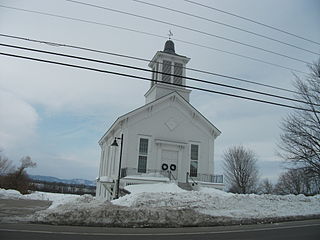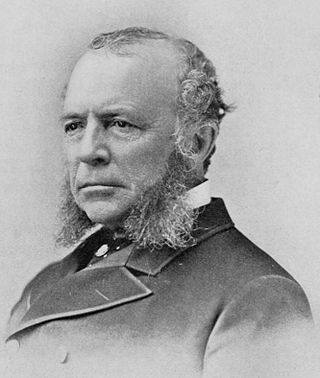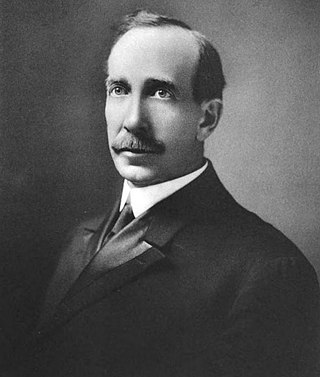
Addison County is a county located in the U.S. state of Vermont. As of the 2020 census,the population was 37,363. Its shire town is the town of Middlebury.

Ferrisburgh is a town in Addison County,Vermont,United States. It was founded June 24,1762. The population was 2,646 at the 2020 census. The town is sometimes spelled Ferrisburg.

Vergennes is a city located in the northwest quadrant of Addison County,Vermont,United States. The municipality is bordered by the towns of Ferrisburgh,Panton,and Waltham. As of the 2020 census,its population was 2,553. It is the smallest of Vermont's 10 cities in terms of population,though the city of Winooski has the smallest area. It was the first city chartered in the state of Vermont and is the only city in Addison County.

Middlebury is the shire town of Addison County,Vermont,United States. As of the 2020 census,the population was 9,152. Middlebury is home to Middlebury College and the Henry Sheldon Museum of Vermont History.

Jacob Collamer was an American politician from Vermont. He served in the U.S. House of Representatives,as Postmaster General in the cabinet of President Zachary Taylor,and as a U.S. Senator.

Edward John Phelps was a lawyer and diplomat from Vermont. He is notable for his service as Envoy to Court of St. James's from 1885 to 1889. In addition,Phelps was a founder of the American Bar Association,and served as its president from 1880 to 1881.

Lawrence Brainerd was an American businessman,abolitionist and United States Senator from Vermont. A longtime anti-slavery activist,after leaving the Jacksonians in the 1830s,Brainerd was active in the Whig,Liberty,and Free Soil parties,and was one of the organizers of the Republican Party when it was formed as the main anti-slavery party in the mid-1850s. Brainerd's longtime commitment to the cause of abolition was recognized in 1854,when opponents of slavery in the Vermont General Assembly chose him to fill a five-month vacancy in the United States Senate.

Frederick Holbrook was an American farmer,businessman,and Governor of the State of Vermont. Active in politics and government,first as a Whig,and later as a Republican,he was most notable for his service as the 27th governor of Vermont from 1861 to 1863.

Frederick Enoch Woodbridge was a nineteenth-century politician and lawyer from Vermont. He served as a U.S. Representative from Vermont.

Addison is a town in Addison County,Vermont,United States. It was founded October 14,1761. The population was 1,365 at the 2020 census.

John Strong was an early Vermont farmer,militia officer and government leader who served as Speaker of the Vermont House of Representatives.

Allen R. Sturtevant was a Vermont attorney and judge. His most notable work was as an associate justice of the Vermont Supreme Court from 1938 to 1948.
Enoch Woodbridge was a Vermont attorney,politician,and judge. A veteran of the American Revolution,he served as a justice of the Vermont Supreme Court from 1794 to 1800,and chief justice from 1798 to 1800.

Frank Leslie Fish was a Vermont attorney and judge. He was most notable for his service as an associate justice of the Vermont Supreme Court from 1926 to 1927.

John Pierpoint was a Vermont attorney and judge. He served as a justice of the Vermont Supreme Court from 1857 until his death,and was Chief Justice beginning in 1865.

The Gen. Samuel Strong House is a historic house on West Main Street in Vergennes,Vermont. Built in 1796,it is one of Vermont's finest examples late Georgian/early Federal period architecture. It was listed on the National Register of Historic Places in 1973.
Roswell Hopkins was a farmer,businessman,and government official in Vermont and New York. He served as Secretary of State of Vermont from 1788 to 1802,and was the founder of the town of Hopkinton,New York.
Jabez G. Fitch was a businessman and political figure from Vermont. Among the offices in which he served was United States Marshal for Vermont,a position he held from 1794 to 1801.
John Pettes was a businessman and public official who was active in Windsor,Vermont. Among the offices in which he served were Sheriff of Windsor County (1837-1839) and United States Marshal for the District of Vermont (1849-1853).

Daniel Roberts was an American attorney and politician from Vermont. Involved in the Abolitionist movement as well as reform causes including Temperance,he was active in the Liberty,Free Soil,and Democratic parties before becoming identified with the Republican Party when it was founded in the mid-1850s as America's main antislavery party.
















